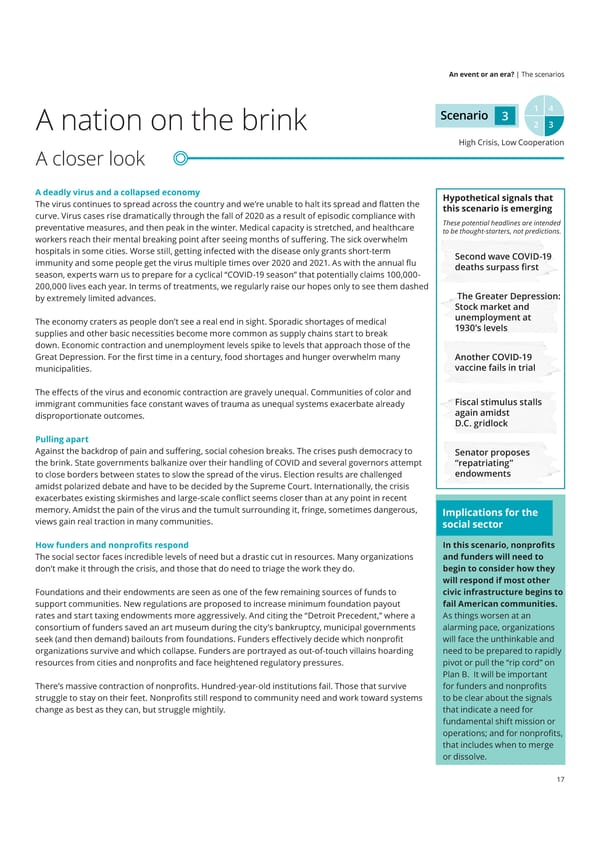An event or an era? | The scenarios Scenario 3 1 4 A nation on the brink 2 3 High Crisis, Low Cooperation A closer look A deadly virus and a collapsed economy Hypothetical signals that The virus continues to spread across the country and we’re unable to halt its spread and flatten the this scenario is emerging curve. Virus cases rise dramatically through the fall of 2020 as a result of episodic compliance with These potential headlines are intended preventative measures, and then peak in the winter. Medical capacity is stretched, and healthcare to be thought-starters, not predictions. workers reach their mental breaking point after seeing months of suffering. The sick overwhelm hospitals in some cities. Worse still, getting infected with the disease only grants short-term Second wave COVID-19 immunity and some people get the virus multiple times over 2020 and 2021. As with the annual flu deaths surpass first season, experts warn us to prepare for a cyclical “COVID-19 season” that potentially claims 100,000- 200,000 lives each year. In terms of treatments, we regularly raise our hopes only to see them dashed by extremely limited advances. The Greater Depression: Stock market and The economy craters as people don’t see a real end in sight. Sporadic shortages of medical unemployment at supplies and other basic necessities become more common as supply chains start to break 1930’s levels down. Economic contraction and unemployment levels spike to levels that approach those of the Great Depression. For the first time in a century, food shortages and hunger overwhelm many Another COVID-19 municipalities. vaccine fails in trial The effects of the virus and economic contraction are gravely unequal. Communities of color and immigrant communities face constant waves of trauma as unequal systems exacerbate already Fiscal stimulus stalls disproportionate outcomes. again amidst D.C. gridlock Pulling apart Against the backdrop of pain and suffering, social cohesion breaks. The crises push democracy to Senator proposes the brink. State governments balkanize over their handling of COVID and several governors attempt “repatriating” to close borders between states to slow the spread of the virus. Election results are challenged endowments amidst polarized debate and have to be decided by the Supreme Court. Internationally, the crisis exacerbates existing skirmishes and large-scale conflict seems closer than at any point in recent memory. Amidst the pain of the virus and the tumult surrounding it, fringe, sometimes dangerous, Implications for the views gain real traction in many communities. social sector How funders and nonprofits respond In this scenario, nonprofits The social sector faces incredible levels of need but a drastic cut in resources. Many organizations and funders will need to don’t make it through the crisis, and those that do need to triage the work they do. begin to consider how they will respond if most other Foundations and their endowments are seen as one of the few remaining sources of funds to civic infrastructure begins to support communities. New regulations are proposed to increase minimum foundation payout fail American communities. rates and start taxing endowments more aggressively. And citing the “Detroit Precedent,” where a As things worsen at an consortium of funders saved an art museum during the city’s bankruptcy, municipal governments alarming pace, organizations seek (and then demand) bailouts from foundations. Funders effectively decide which nonprofit will face the unthinkable and organizations survive and which collapse. Funders are portrayed as out-of-touch villains hoarding need to be prepared to rapidly resources from cities and nonprofits and face heightened regulatory pressures. pivot or pull the “rip cord” on Plan B. It will be important There’s massive contraction of nonprofits. Hundred-year-old institutions fail. Those that survive for funders and nonprofits struggle to stay on their feet. Nonprofits still respond to community need and work toward systems to be clear about the signals change as best as they can, but struggle mightily. that indicate a need for fundamental shift mission or operations; and for nonprofits, that includes when to merge or dissolve. 17
 US Deloitte Monitor Institute Page 16 Page 18
US Deloitte Monitor Institute Page 16 Page 18